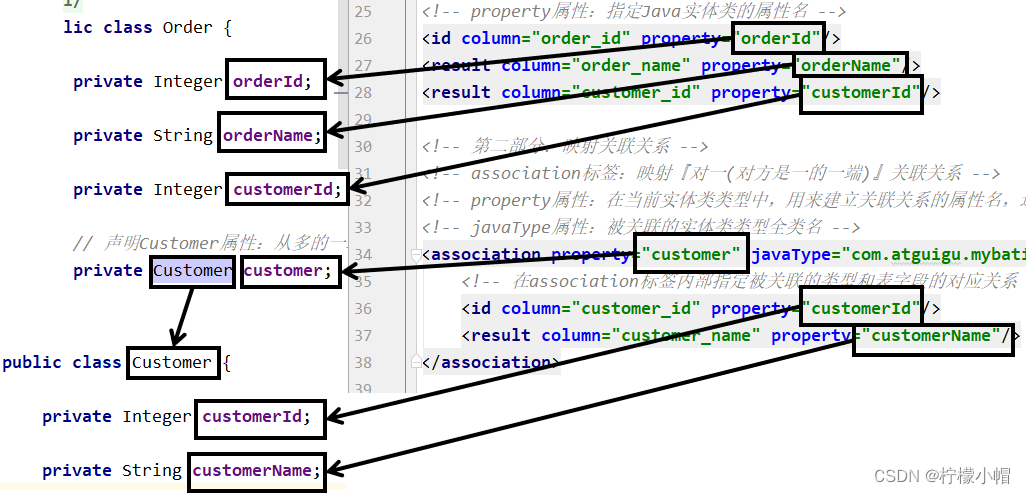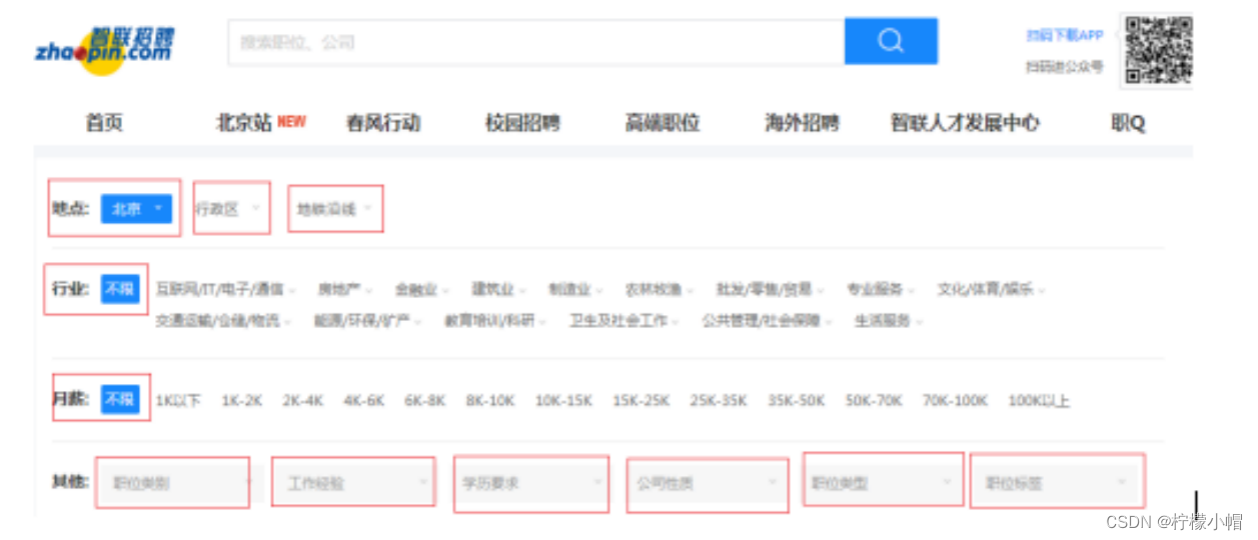SSM - Springboot - MyBatis-Plus 全栈体系(十六)
第三章 MyBatis
三、MyBatis 多表映射
2. 对一映射
2.1 需求说明
- 根据 ID 查询订单,以及订单关联的用户的信息!
2.2 OrderMapper 接口
public interface OrderMapper {
Order selectOrderWithCustomer(Integer orderId);
}
2.3 OrderMapper.xml 配置文件
<!-- 创建resultMap实现“对一”关联关系映射 -->
<!-- id属性:通常设置为这个resultMap所服务的那条SQL语句的id加上“ResultMap” -->
<!-- type属性:要设置为这个resultMap所服务的那条SQL语句最终要返回的类型 -->
<resultMap id="selectOrderWithCustomerResultMap" type="order">
<!-- 先设置Order自身属性和字段的对应关系 -->
<id column="order_id" property="orderId"/>
<result column="order_name" property="orderName"/>
<!-- 使用association标签配置“对一”关联关系 -->
<!-- property属性:在Order类中对一的一端进行引用时使用的属性名 -->
<!-- javaType属性:一的一端类的全类名 -->
<association property="customer" javaType="customer">
<!-- 配置Customer类的属性和字段名之间的对应关系 -->
<id column="customer_id" property="customerId"/>
<result column="customer_name" property="customerName"/>
</association>
</resultMap>
<!-- Order selectOrderWithCustomer(Integer orderId); -->
<select id="selectOrderWithCustomer" resultMap="selectOrderWithCustomerResultMap">
SELECT order_id,order_name,c.customer_id,customer_name
FROM t_order o
LEFT JOIN t_customer c
ON o.customer_id=c.customer_id
WHERE o.order_id=#{orderId}
</select>
- 对应关系可以参考下图:

2.4 Mybatis 全局注册 Mapper 文件
<!-- 注册Mapper配置文件:告诉Mybatis我们的Mapper配置文件的位置 -->
<mappers>
<!-- 在mapper标签的resource属性中指定Mapper配置文件以“类路径根目录”为基准的相对路径 -->
<mapper resource="mappers/OrderMapper.xml"/>
</mappers>
2.5 junit 测试程序
@Slf4j
public class MyBatisTest {
private SqlSession session;
// junit会在每一个@Test方法前执行@BeforeEach方法
@BeforeEach
public void init() throws IOException {
session = new SqlSessionFactoryBuilder()
.build(
Resources.getResourceAsStream("mybatis-config.xml"))
.openSession();
}
@Test
public void testRelationshipToOne() {
OrderMapper orderMapper = session.getMapper(OrderMapper.class);
// 查询Order对象,检查是否同时查询了关联的Customer对象
Order order = orderMapper.selectOrderWithCustomer(2);
log.info("order = " + order);
}
// junit会在每一个@Test方法后执行@@AfterEach方法
@AfterEach
public void clear() {
session.commit();
session.close();
}
}
2.6 关键词
- 在“对一”关联关系中,我们的配置比较多,但是关键词就只有:association 和 javaType
3. 对多映射
3.1 需求说明
- 查询客户和客户关联的订单信息!
3.2 CustomerMapper 接口
public interface CustomerMapper {
Customer selectCustomerWithOrderList(Integer customerId);
}
3.3 CustomerMapper.xml 文件
<!-- 配置resultMap实现从Customer到OrderList的“对多”关联关系 -->
<resultMap id="selectCustomerWithOrderListResultMap"
type="customer">
<!-- 映射Customer本身的属性 -->
<id column="customer_id" property="customerId"/>
<result column="customer_name" property="customerName"/>
<!-- collection标签:映射“对多”的关联关系 -->
<!-- property属性:在Customer类中,关联“多”的一端的属性名 -->
<!-- ofType属性:集合属性中元素的类型 -->
<collection property="orderList" ofType="order">
<!-- 映射Order的属性 -->
<id column="order_id" property="orderId"/>
<result column="order_name" property="orderName"/>
</collection>
</resultMap>
<!-- Customer selectCustomerWithOrderList(Integer customerId); -->
<select id="selectCustomerWithOrderList" resultMap="selectCustomerWithOrderListResultMap">
SELECT c.customer_id,c.customer_name,o.order_id,o.order_name
FROM t_customer c
LEFT JOIN t_order o
ON c.customer_id=o.customer_id
WHERE c.customer_id=#{customerId}
</select>
- 对应关系可以参考下图:

3.4 Mybatis 全局注册 Mapper 文件
<!-- 注册Mapper配置文件:告诉Mybatis我们的Mapper配置文件的位置 -->
<mappers>
<!-- 在mapper标签的resource属性中指定Mapper配置文件以“类路径根目录”为基准的相对路径 -->
<mapper resource="mappers/OrderMapper.xml"/>
<mapper resource="mappers/CustomerMapper.xml"/>
</mappers>
3.5 junit 测试程序
@Test
public void testRelationshipToMulti() {
CustomerMapper customerMapper = session.getMapper(CustomerMapper.class);
// 查询Customer对象同时将关联的Order集合查询出来
Customer customer = customerMapper.selectCustomerWithOrderList(1);
log.info("customer.getCustomerId() = " + customer.getCustomerId());
log.info("customer.getCustomerName() = " + customer.getCustomerName());
List<Order> orderList = customer.getOrderList();
for (Order order : orderList) {
log.info("order = " + order);
}
}
3.6 关键词
- 在“对多”关联关系中,同样有很多配置,但是提炼出来最关键的就是:“collection”和“ofType”
4. 多表映射总结
4.1 多表映射优化
| setting 属性 | 属性含义 | 可选值 | 默认值 |
|---|---|---|---|
| autoMappingBehavior | 指定 MyBatis 应如何自动映射列到字段或属性。 NONE 表示关闭自动映射;PARTIAL 只会自动映射没有定义嵌套结果映射的字段。 FULL 会自动映射任何复杂的结果集(无论是否嵌套)。 | NONE, PARTIAL, FULL | PARTIAL |
-
我们可以将 autoMappingBehavior 设置为 full,进行多表 resultMap 映射的时候,可以省略符合列和属性命名映射规则(列名=属性名,或者开启驼峰映射也可以自定映射)的 result 标签!
-
修改 mybatis-sconfig.xml:
<!--开启resultMap自动映射 -->
<setting name="autoMappingBehavior" value="FULL"/>
- 修改 teacherMapper.xml
<resultMap id="teacherMap" type="teacher">
<id property="tId" column="t_id" />
<!-- 开启自动映射,并且开启驼峰式支持!可以省略 result!-->
<!-- <result property="tName" column="t_name" />-->
<collection property="students" ofType="student" >
<id property="sId" column="s_id" />
<!-- <result property="sName" column="s_name" />-->
</collection>
</resultMap>
4.2 多表映射总结
| 关联关系 | 配置项关键词 | 所在配置文件和具体位置 |
|---|---|---|
| 对一 | association 标签/javaType 属性/property 属性 | Mapper 配置文件中的 resultMap 标签内 |
| 对多 | collection 标签/ofType 属性/property 属性 | Mapper 配置文件中的 resultMap 标签内 |
四、MyBatis 动态语句
1. 动态语句需求和简介
- 经常遇到很多按照很多查询条件进行查询的情况,比如智联招聘的职位搜索等。其中经常出现很多条件不取值的情况,在后台应该如何完成最终的 SQL 语句呢?

- 动态 SQL 是 MyBatis 的强大特性之一。如果你使用过 JDBC 或其它类似的框架,你应该能理解根据不同条件拼接 SQL 语句有多痛苦,例如拼接时要确保不能忘记添加必要的空格,还要注意去掉列表最后一个列名的逗号。利用动态 SQL,可以彻底摆脱这种痛苦。
- 使用动态 SQL 并非一件易事,但借助可用于任何 SQL 映射语句中的强大的动态 SQL 语言,MyBatis 显著地提升了这一特性的易用性。
- 如果你之前用过 JSTL 或任何基于类 XML 语言的文本处理器,你对动态 SQL 元素可能会感觉似曾相识。在 MyBatis 之前的版本中,需要花时间了解大量的元素。借助功能强大的基于 OGNL 的表达式,MyBatis 3 替换了之前的大部分元素,大大精简了元素种类,现在要学习的元素种类比原来的一半还要少。
2. if 和 where 标签
- 使用动态 SQL 最常见情景是根据条件包含 where / if 子句的一部分。比如:
<!-- List<Employee> selectEmployeeByCondition(Employee employee); -->
<select id="selectEmployeeByCondition" resultType="employee">
select emp_id,emp_name,emp_salary from t_emp
<!-- where标签会自动去掉“标签体内前面多余的and/or” -->
<where>
<!-- 使用if标签,让我们可以有选择的加入SQL语句的片段。这个SQL语句片段是否要加入整个SQL语句,就看if标签判断的结果是否为true -->
<!-- 在if标签的test属性中,可以访问实体类的属性,不可以访问数据库表的字段 -->
<if test="empName != null">
<!-- 在if标签内部,需要访问接口的参数时还是正常写#{} -->
or emp_name=#{empName}
</if>
<if test="empSalary > 2000">
or emp_salary>#{empSalary}
</if>
<!--
第一种情况:所有条件都满足 WHERE emp_name=? or emp_salary>?
第二种情况:部分条件满足 WHERE emp_salary>?
第三种情况:所有条件都不满足 没有where子句
-->
</where>
</select>
3. set 标签
<!-- void updateEmployeeDynamic(Employee employee) -->
<update id="updateEmployeeDynamic">
update t_emp
<!-- set emp_name=#{empName},emp_salary=#{empSalary} -->
<!-- 使用set标签动态管理set子句,并且动态去掉两端多余的逗号 -->
<set>
<if test="empName != null">
emp_name=#{empName},
</if>
<if test="empSalary < 3000">
emp_salary=#{empSalary},
</if>
</set>
where emp_id=#{empId}
<!--
第一种情况:所有条件都满足 SET emp_name=?, emp_salary=?
第二种情况:部分条件满足 SET emp_salary=?
第三种情况:所有条件都不满足 update t_emp where emp_id=?
没有set子句的update语句会导致SQL语法错误
-->
</update>
4. trim 标签(了解)
-
使用 trim 标签控制条件部分两端是否包含某些字符
- prefix 属性:指定要动态添加的前缀
- suffix 属性:指定要动态添加的后缀
- prefixOverrides 属性:指定要动态去掉的前缀,使用“|”分隔有可能的多个值
- suffixOverrides 属性:指定要动态去掉的后缀,使用“|”分隔有可能的多个值
<!-- List<Employee> selectEmployeeByConditionByTrim(Employee employee) -->
<select id="selectEmployeeByConditionByTrim" resultType="com.atguigu.mybatis.entity.Employee">
select emp_id,emp_name,emp_age,emp_salary,emp_gender
from t_emp
<!-- prefix属性指定要动态添加的前缀 -->
<!-- suffix属性指定要动态添加的后缀 -->
<!-- prefixOverrides属性指定要动态去掉的前缀,使用“|”分隔有可能的多个值 -->
<!-- suffixOverrides属性指定要动态去掉的后缀,使用“|”分隔有可能的多个值 -->
<!-- 当前例子用where标签实现更简洁,但是trim标签更灵活,可以用在任何有需要的地方 -->
<trim prefix="where" suffixOverrides="and|or">
<if test="empName != null">
emp_name=#{empName} and
</if>
<if test="empSalary > 3000">
emp_salary>#{empSalary} and
</if>
<if test="empAge <= 20">
emp_age=#{empAge} or
</if>
<if test="empGender=='male'">
emp_gender=#{empGender}
</if>
</trim>
</select>
5. choose / when / otherwise 标签
-
在多个分支条件中,仅执行一个。
- 从上到下依次执行条件判断
- 遇到的第一个满足条件的分支会被采纳
- 被采纳分支后面的分支都将不被考虑
- 如果所有的 when 分支都不满足,那么就执行 otherwise 分支
<!-- List<Employee> selectEmployeeByConditionByChoose(Employee employee) -->
<select id="selectEmployeeByConditionByChoose" resultType="com.atguigu.mybatis.entity.Employee">
select emp_id,emp_name,emp_salary from t_emp
where
<choose>
<when test="empName != null">emp_name=#{empName}</when>
<when test="empSalary < 3000">emp_salary < 3000</when>
<otherwise>1=1</otherwise>
</choose>
<!--
第一种情况:第一个when满足条件 where emp_name=?
第二种情况:第二个when满足条件 where emp_salary < 3000
第三种情况:两个when都不满足 where 1=1 执行了otherwise
-->
</select>
6. foreach 标签
6.1 基本用法
- 用批量插入举例
<!--
collection属性:要遍历的集合
item属性:遍历集合的过程中能得到每一个具体对象,在item属性中设置一个名字,将来通过这个名字引用遍历出来的对象
separator属性:指定当foreach标签的标签体重复拼接字符串时,各个标签体字符串之间的分隔符
open属性:指定整个循环把字符串拼好后,字符串整体的前面要添加的字符串
close属性:指定整个循环把字符串拼好后,字符串整体的后面要添加的字符串
index属性:这里起一个名字,便于后面引用
遍历List集合,这里能够得到List集合的索引值
遍历Map集合,这里能够得到Map集合的key
-->
<foreach collection="empList" item="emp" separator="," open="values" index="myIndex">
<!-- 在foreach标签内部如果需要引用遍历得到的具体的一个对象,需要使用item属性声明的名称 -->
(#{emp.empName},#{myIndex},#{emp.empSalary},#{emp.empGender})
</foreach>
6.2 批量更新时需要注意
- 上面批量插入的例子本质上是一条 SQL 语句,而实现批量更新则需要多条 SQL 语句拼起来,用分号分开。也就是一次性发送多条 SQL 语句让数据库执行。此时需要在数据库连接信息的 URL 地址中设置:
alex.dev.url=jdbc:mysql:///mybatis-example?allowMultiQueries=true
- 对应的 foreach 标签如下:
<!-- int updateEmployeeBatch(@Param("empList") List<Employee> empList) -->
<update id="updateEmployeeBatch">
<foreach collection="empList" item="emp" separator=";">
update t_emp set emp_name=#{emp.empName} where emp_id=#{emp.empId}
</foreach>
</update>
6.3 关于 foreach 标签的 collection 属性
- 如果没有给接口中 List 类型的参数使用@Param 注解指定一个具体的名字,那么在 collection 属性中默认可以使用 collection 或 list 来引用这个 list 集合。这一点可以通过异常信息看出来:
Parameter 'empList' not found. Available parameters are [arg0, collection, list]
- 在实际开发中,为了避免隐晦的表达造成一定的误会,建议使用@Param 注解明确声明变量的名称,然后在 foreach 标签的 collection 属性中按照@Param 注解指定的名称来引用传入的参数。
7. sql 片段
7.1 抽取重复的 SQL 片段
<!-- 使用sql标签抽取重复出现的SQL片段 -->
<sql id="mySelectSql">
select emp_id,emp_name,emp_age,emp_salary,emp_gender from t_emp
</sql>
7.2 引用已抽取的 SQL 片段
<!-- 使用include标签引用声明的SQL片段 -->
<include refid="mySelectSql"/>